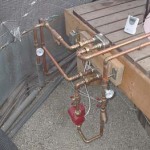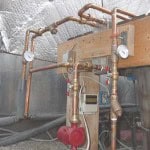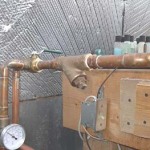- Diverting water from the floor: The easiest method of heating a hot tub is directly from a radiant Zone Manifold. One leg of the manifold is simply dedicated to the task of heating a heat exchanger and the heat exchanger, in turn, transfers heat to the tub. But in this instance, the hot tub is in a radiantly heated greenhouse 300 ft. from the house. That means that the Zone Manifold is 300 ft. away. Fortunately, the radiant tubing had already been installed into the floor of the greenhouse, so it offered an easy, readily available source of hot water. So, the supply line from the house was cut before it reached the slab manifold in the floor of the greenhouse. The green handled valve in the photo is a diverter valve. Depending upon how the handle is turned, the fluid from this supply line will either flow up, then directly back to the floor, or it will divert to the right and pass through a heat exchanger, THEN return to the floor. But not before it gives a lot of it’s heat to the exchanger. (see next photo)
- A wider view. Every heat exchanger has two sides. On one side the heated fluid enters, heats the exchanger, then flows back to the heat source. The second side of the heat exchanger takes water from a cooler source, passes it through the heat exchanger, warms it, then sends it to….wherever. The two fluids never mingle, only heat flows from one side to the other.
- Transferring the heat: The red circulator pump is taking water from the tub, passing it through the heat exchanger, then sending it 10 degrees warmer back to the tub. A sensor in the tub only activates the circulator when the temperature in the hot tub is below 105 degrees. It’s important to note that, in this somewhat strange application, the tub can only be heated when the floor itself is activated. The tub is essentially stealing heat from the floor. If the circulator running the floor is off, there will be no hot water to divert to the heat exchanger.
- The strainer: An important component in any heat exchanger installation is the in-line strainer. Flat plate heat exchangers consist of twenty or more corrugated stainless steel plates brazed together only a fraction of an inch apart. The narrow channels between these many plates alternate between hot fluid, cold fluid, hot fluid, cold fluid for the entire thickness of the exchanger. The two fluids never contact each other, but they are in extremely close proximity….hence the efficient transfer of heat from one to the other. Without an in-line strainer on both inlet sides of the heat exchanger these narrow channels could become plugged and greatly decrease the performance of the heat exchanger.




